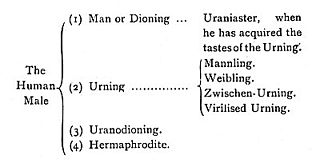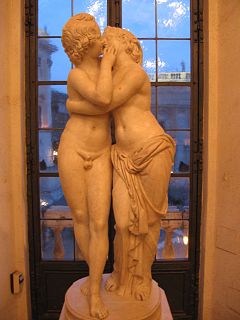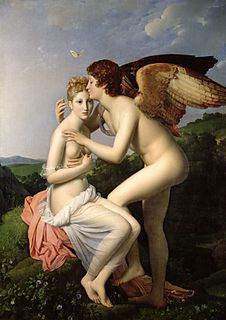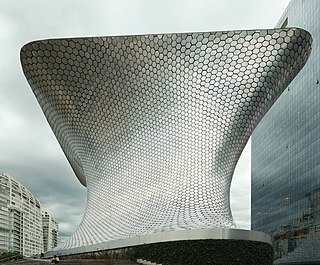Psyche is the Greek term for "soul" or "spirit" (ψυχή).

Psyche is one of the ten most massive asteroids in the asteroid belt. It is over 200 km (120 mi) in diameter and contains a little less than 1% of the mass of the entire asteroid belt. It is thought to be the exposed iron core of a protoplanet. It is the most massive metallic M-type asteroid. Psyche was discovered by the Italian astronomer Annibale de Gasparis on 17 March 1852 from Naples and named after the Greek mythological figure Psyche.

Collective unconscious, a term coined by Carl Jung, refers to structures of the unconscious mind which are shared among beings of the same species. According to Jung, the human collective unconscious is populated by instincts and by archetypes: universal symbols such as The Great Mother, the Wise Old Man, the Shadow, the Tower, Water, the Tree of Life, and many more.

Till We Have Faces: A Myth Retold is a 1956 novel by C. S. Lewis. It is a retelling of Cupid and Psyche, based on its telling in a chapter of The Golden Ass of Apuleius. This story had haunted Lewis all his life, because he realized that some of the main characters' actions were illogical. As a consequence, his retelling of the story is characterized by a highly developed character, the narrator, with the reader being drawn into her reasoning and her emotions. This was his last novel, and he considered it his most mature, written in conjunction with his wife, Joy Davidman.

Analytical psychology, also called Jungian psychology, is a school of psychotherapy which originated in the ideas of Carl Jung, a Swiss psychiatrist. It emphasizes the importance of the individual psyche and the personal quest for wholeness.

Uranian is a 19th-century term that referred to a person of a third sex—originally, someone with "a female psyche in a male body" who is sexually attracted to men, and later extended to cover homosexual gender variant females, and a number of other sexual types. The term was first published by activist Karl Heinrich Ulrichs (1825–95) in a series of five booklets (1864–65) collected under the title Forschungen über das Räthsel der mannmännlichen Liebe. Ulrichs derived Uranian from the Greek goddess Aphrodite Urania, who was created out of the god Uranus' testicles. Therefore, it represents the homosexual gender, while Dionian (Dioning), derived from Aphrodite Dionea, represents the heterosexual gender. Ulrichs developed his terminology before the first public use of the term homosexual, which appeared in 1869 in a pamphlet published anonymously by Karl-Maria Kertbeny (1824–82).

The Metamorphoses of Apuleius, which Augustine of Hippo referred to as The Golden Ass, is the only ancient Roman novel in Latin to survive in its entirety.

"Ode to Psyche" is a poem by John Keats written in spring 1819. The poem is the first of his 1819 odes, which include "Ode on a Grecian Urn" and "Ode to a Nightingale". "Ode to Psyche" is an experiment in the ode genre, and Keats's attempt at an expanded version of the sonnet format that describes a dramatic scene. The poem serves as an important departure from Keats's early poems, which frequently describe an escape into the pleasant realms of one's imagination. Keats uses the imagination to show the narrator's intent to resurrect Psyche and reincarnate himself into Eros (love). Keats attempts this by dedicating an "untrodden region" of his mind to the worship of the neglected goddess.
In psychology, the psyche is the totality of the human mind, conscious and unconscious. Psychology is the scientific or objective study of the psyche. The word has a long history of use in psychology and philosophy, dating back to ancient times, and represents one of the fundamental concepts for understanding human nature from a scientific point of view. The English word soul is sometimes used synonymously, especially in older texts.

Psyche Revived by Cupid's Kiss is a sculpture by Antonio Canova first commissioned in 1787 by Colonel John Campbell. It is regarded as a masterpiece of Neoclassical sculpture, but shows the mythological lovers at a moment of great emotion, characteristic of the emerging movement of Romanticism. It represents the god Cupid in the height of love and tenderness, immediately after awakening the lifeless Psyche with a kiss. The story of Cupid and Psyche is taken from Lucius Apuleius' Latin novel The Golden Ass, and was popular in art.

"Sex 'n' Money" is a song by DJ Paul Oakenfold from his second solo artist release A Lively Mind. It features producer Pharrell on the vocal track.

Psyche is a scientific journal of entomology which was established in 1874 by the Cambridge Entomological Club as a "journal for the publication of biological contributions upon Arthropoda from any competent person". The name of the journal is derived from the Ancient Greek word for butterfly.
Psyché is a five-act, free verse tragicomédie et ballet, originally written as a prose text by Molière and versified in collaboration with Pierre Corneille and Philippe Quinault, with music composed by Jean-Baptiste Lully. The plot is based on the story of Cupid and Psyche in The Golden Ass, written in the 2nd century by Apuleius. It was first performed on 17 January 1671 before the royal court of Louis XIV at the Théâtre des Tuileries, with ballets by Pierre Beauchamps, Anthoine des Brosses, and Nicolas Delorge, and spectacular scenery and special effects designed by Carlo Vigarani.

In Greek mythology, Eros is the Greek god of love. His Roman counterpart was Cupid ("desire"). Normally, he is described as one of the children of Aphrodite and Ares, and with most of his siblings, was a part of group, consisting of winged love gods. However, sometimes he is also described as one of the primordial gods, but then, he is most often identified with Phanes.
Psyché was a 36-gun vessel built between February 1798 and 1799 at Basse-Indre (Nantes) as a privateer. As a privateer she had an inconclusive but bloody encounter with HMS Wilhelmina of the Royal Navy, commanded by Commander Henry Lambert, off the Indian coast in April 1804. The French then brought her into service in June 1804 as the frigate Psyché. In February 1805 she encountered San Fiorenzo, under the command of the same Henry Lambert, now an acting captain. After a sanguinary engagement of over three hours, Psyché surrendered. The British took her into service as HMS Psyche. In British service she captured several prizes and took part in the capture of Mauritius and in an operation in Java. She was broken up at Ferrol in 1812.

Psyche-Out is a character from the G.I. Joe: A Real American Hero toyline, comic books and animated series of the 1980s. He is the G.I. Joe team's deceptive warfare specialist and debuted in 1987.

The marble Cupid and Psyche conserved in the Capitoline Museums, Rome, is a 1st or 2nd century CE Roman copy of a late Hellenistic original. It was given to the nascent Capitoline Museums by Pope Benedict XIV in 1749, shortly after its discovery. Its graceful balance and sentimental appearance made it a favourite among the neoclassical generations of artists and visitors, and it was copied in many materials from bronze to biscuit porcelain. Antonio Canova consciously set out to outdo the Antique original with his own Cupid and Psyche of 1808
Structure & Dynamics of the Psyche is Volume 8 in The Collected Works of C. G. Jung, a series of books published by Princeton University Press in the U.S. and Routledge & Kegan Paul in the U.K. It is a revised translation of one of Jung's most important longer works. There is an appendix of four shorter papers on personality type, published between 1913 and 1935.

Psyche is a planned orbiter mission that will explore the origin of planetary cores by studying the metallic asteroid,16 Psyche. Lindy Elkins-Tanton of Arizona State University is the Principal Investigator who proposed this mission for NASA's Discovery Program. NASA's Jet Propulsion Laboratory (JPL) will manage the project.

















